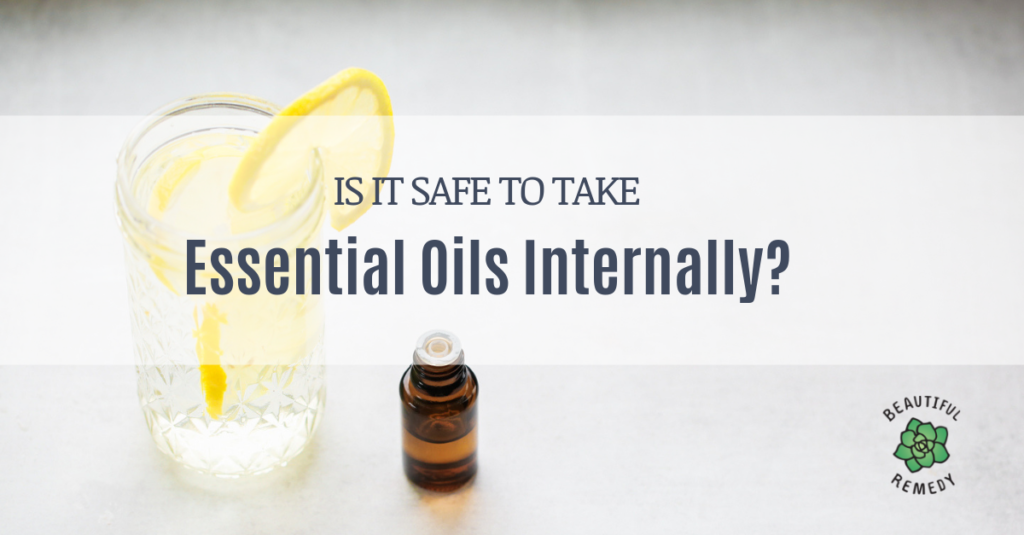Is it really safe to TAKE ESSENTIAL OILS INTERNALLY?
*This article has been updated 2/21/19
If you google this topic today, you’ll find that it’s SUPER controversial. Some certified aromatherapists claim that essential oils should never be ingested. On the other hand, other aromatherapists and many medical professionals say taking essential oils internally is safe.
Who do we believe?
It is my belief that we can safely take essential oils internally if they are a pure therapeutic grade and the label states it’s safe to do so. Read on to find out why I have come to this conclusion.
It’s important to note that the FDA has recognized some essential oils to be safe for consuming. You can find these oils labeled with with the GRAS standard (Generally Recognized as Safe) along with instructions on how to take them.
Furthermore, Jade Shutes, founder and educator of the New York Institute of Aromatic Studies, states “based upon the growing interest and indeed the growing use of essential oils internally, I believe it is becoming imperative that we in the aromatherapy industry develop a better understanding and richer knowledge base regarding the internal use of essential oils.”
Jade goes on to say,
“We all take a certain amount of essential oils internally each day through our food and drinks. Essential oils and numerous components derived from them are widely used in many foods and beverages for flavoring and food preservation.”
“Although I am not a strong advocate of taking essential oils internally without just cause, I have used essential oils for myself and friends in vaginal and rectal suppositories for specific conditions (e.g. in the treatment of respiratory infections and hemorrhoids), cough syrups, teas and sometimes in a spoonful of honey. Each year I make up a supply of cough syrup containing herbal and aromatic ingredients. I always use my own essential oil based mouth wash and drink a fair amount of herbal teas (thereby taking essential oils internally as well) including fennel and other aromatic plant teas.” -Jade Shutes
Dr. Eric Zielinski drives home a big point that essential oils are safe for internal use. Period. He says “there are no scientific, evidence-based, anatomical, physiological, or even logical reasons to say that essentials oils are unsafe for human consumption. With proper use, the benefits of essential oils far outweigh any potential side effects.
It’s crazy to me that some people are so worried about the safety of taking essential oils internally, yet we take all kinds of medications that do way more harm to our bodies than EO’s would ever do.
I’ve been taking essential oils internally for various health issues for over 5 years now. I’ve never experienced undesired side effects from it. Only POSITIVE.
It seams to me that there are just not enough studies done and the “unknown” is what makes those leery about taking EO’s internally claim that they are not safe. This isn’t right and I agree with Jade that we need to develop a deeper understanding when it comes to this topic.
In the meantime, I’ll continue to use my therapeutic grade essential oils internally because I have seen the positive outcome in doing so. I know that this is the right for my family. I feel very empowered that I can use EO’s safely from the brand I trust.
If you’re among the “Oil Ingestors”, here are some tips to taking them internally:
Drinking them in water
EO’s don’t mix with water so you’ll want to give your water glass a good shake before taking a drink. You can also use a dispersant to help mix the oils into your water better.
Here are some ideas to disperse your oils
- Sea salt or Himalayan salt – for larger water bottles, mix just a pinch of salt with your drops of essential oils first, then add your water. This will disperse the oils into the water and you will hardly notice the salt. It will also give you some electrolytes, an added bonus!
- Aloe Vera juice – you can find a pure aloe juice in most health food stores. Aloe Vera is wonderful for digestive health. Mix the Aloe with your oils then add your water. Aloe Vera does have an astringent taste so you may want to test this out first before you make a big jug of water.
- Mashed fruit – fruit-infused water is delightfully delicious! Mash up some berries, citrus fruits or even cucumber and mix with your oil before adding to your water.
- Raw local honey – I often use raw honey in hot tea and oils mix very well with it. Honey will add just a touch of sweetness to your water and help to disperse your oils. Make sure to use RAW honey. Conventional honey sold in the markets is highly processed, has no health benefits and is just sugar disguised as honey.
- Add oils to your smoothies or protein shakes!
Many essential oils, especially the citrus oils, can breakdown plastic containers causing chemicals to leach into your water. This means you will end up drinking harmful toxins, and that’s never a good idea. Always use a glass or stainless steel water bottle when using EO’s.
Taking them in an empty veggi capsule
For those that don’t like the taste of EO’s or for EO’s that are “hot”, veggi capsules are a great option.
Simply drop 1-2 drops of EO in the capsule, and take with water. For the hot oils like oregano, cinnamon, clove & thyme, it’s best to add a carrier oil to the capsule to dilute the EO’s a bit so they won’t burn your internal organs. I find that if I take these oils with food, I have no discomfort at all. Again, use your best judgment.
Finally, the biggest rule with taking EO’s internally, in my opinion, is to take only small doses at a time. ONE to TWO drops is the most you’ll need in most cases! Also, I try to take EO’s internally only when I need it, not daily as a “preventative”.
Let me know what you think! Do you take EO’s internally?
Posts may contain affiliate links. If you purchase a product through an affiliate link, your costs will be the same but Beautiful Remedy will receive a small commission. This helps cover some of the costs for this site. We appreciate your support!


I love a drop or two of lemon, frankincense, lavender and sometimes rosemary in my water with stevia. I switch it up. Super fresh and yummy. I just give it a shake before drinking each time. I feel great an I feel like I’ve had an energy and mental clarity boost since I started. Definitely helps me to drink more water. Works for me. I don’t push it on others.
Nice! I enjoy pure essential oils in my water too.
Oils mix with other oils/fats has anyone considerd eating essential oils with coconut oil or butters? Seems like using a fat to dissolve the essential oil is much safer than using water.
As a distiller its basic knowledge that essential oils always float to the top of water. Thats how we seperate them.
Great idea! Thanks for sharing.
Hi great article I definitely think there needs to be more research on this topic. I’ve been taking citrus essential oils in my water for years. I use one to two drops in a large glass of soda water two or three times a day. I have never had any issues or problems In fact I feel great.
I am curious about Fenugreek Essential Oil and whether it is safe to ingest it, when mixed with something other than water.
Thank you,
Hi Mike, thanks for your comment! I’m not familiar with Fenugreek essential oil, but it’s a great question! Sorry I couldn’t be of more help.
I am a qualified Aromatherapist and need to stress that essential oils should not be ingested.
It is also important to check on what medication/ health issues a person has or at least point it out when suggesting essential oil blends without a consultation as the oils may work contrary to the prescribed medication.
Hi Anita, Thanks for your comment! This topic is very controversial among many aromatherapist and medical professionals. We ingest essential oils every day with our food. The main concern is the concentration of essential oils and the quality. I only trust doterra’s oils for ingesting and always recommend customers to follow the company’s dosage recommendation. The FDA has labeled certain oils with the GRAS standard and are considered safe to consume.
Thanks so much for your message! I’m new to EOs & having a BA in 🧫Biology & 🧪Chemistry with a passion for natural therapy, I’m educating myself to achieve optimal ♥️health & wellness. Sadly, I suffer from chronic pain, fibromyalgia & autoimmune disease. I’m finding relief in using EOs & I’m concerned about daily ingestion. Will you please recommend only one or two EO 📚books covering usage, safety & recipes. Thanks – free to guide & help me with my knowledge.
Hi Karen! Great! I’m glad you found it useful. My favorite book to refer to is The Essential Life book. You can get it at oillife.com. They also have a great app! It’s the green icon with a leaf.
Thank you for this information. This really help me a lot. Never used EO internally for the same reason, oil and water don’t mix therefore I will be ingesting a full strength of EO. This info does make more sense. Thank you.
Any lists of EO that can and can not be ingested? I would appreciate if you can email it to me. Thanks again.
Thank you! I’m glad you found it helpful. I do take essential oils internally, but only use doTERRA because I trust their quality. I like to take them in an empty gel capsule with a little carrier oil. I find taking them internally works better for certain circumstances such as stomach upset or to boost the immune system. I don’t have a list on hand of oils that shouldn’t be ingested, but I do like to refer to the book called The Essential Life. You can find it at oillife.com. It’s a great resource to have on hand!